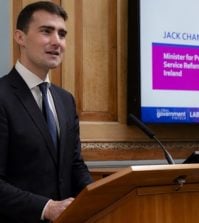Spare room superheroes: how finance departments met the pandemic threat

When COVID-19 struck, finance departments around the world sent their staff home – and asked them to put their economies into induced comas. At the Global Government Finance Summit, senior leaders spoke candidly about the challenges of performing radical economic surgery remotely, and considered the first steps to recovery. Matt Ross reports
“This crisis was entirely different from any crisis that anybody had ever seen before,” said Pablo de Ramón-Laca. When the last great economic disruption arrived in 2007-08, he noted, the problem had its roots in the economy: the global financial crisis “originated in the banking sector, and affected the ‘real’ economy.” By contrast, the pandemic “appeared completely exogenously, affecting first people’s health. And to prevent that, the economy was stopped.”
So for civil servants battling to protect people’s incomes in March 2020, “there was no template: no reasonable expectation of how the economy would respond to the implementation of policies to stop the spread of the virus.” Supporting people to stay in their homes, governments were putting national economies “in a self-induced coma,” he added, “and that has the danger of affecting the banking sector.” In a neat inversion of the challenge a decade ago, “it was in our hands to prevent this real economy crisis from becoming a financial crisis.”
As Director General of Treasury and Financial Policy at Spain’s Ministry of Economic Affairs and Digital Transformation, de Ramón-Laca participated in Spain’s financial and economic response to the pandemic. And at the 2020 Global Government Finance Summit, he met online with his peers from around the world to exchange ideas, share learning, relate experiences – and compare bruises.
Inducing the coma
The annual Finance Summit brings together senior leaders from national treasuries and finance departments for informal discussions on how to address shared problems and improve their organisations. And when this year’s event was held in October, there was plenty to discuss. As your correspondent commented at the event’s outset, over the years following the Summit’s launch in 2015 “the issues facing finance departments evolved, but they remained recognisable. The fact that we’re online this year reflects the fact that those evolving challenges have been overtaken by a single, vast, global problem that we have in common – one that’s created a very sudden and dramatic change in national governments’ financial positions and their goals.”
Kicking off the first session, de Ramón-Laca explained how his own government had acted to contain the economic, financial and social damage caused by the pandemic. When the virus arrived in Europe, he recalled, Spain was in a vulnerable position: urban areas are very densely populated, the country receives 82m visitors a year, and “social culture is anything but distant!” And it wasn’t clear until mid-March that “COVID was fully embedded in Spain”: the lockdown measures “were drastic, but they were necessary” given the size of the problem.

The director general – who oversees government debt, financial policy and market regulation – explained that the government’s goal “during this induced coma was to replace incomes, save jobs, preserve the economic fabric of society at least during the initial confinement, and then to adapt to the political economy issues around mobility restrictions.” When the EU relaxed borrowing rules in response to the pandemic, “the debt management office was unleashed to issue first and ask questions later” – securing the resources to fund support packages whose duration and scale could not be predicted.
Finding the money
Compared with the financial crisis, he added, the EU found it easier this time to build a consensus on the need for rapid, concerted action. In 2008, the ‘moral hazard’ issues around rescuing banks and nations from their own mistakes hampered progress; when partners differ on the cause of a problem, he noted, “that’s when collaboration fails.” But “this time round it wasn’t a moral crisis, it was a health crisis – so it was easier to solve those political problems.”
In the days before agreement was found, though, the Spanish Treasury had to act boldly in issuing debt. With staff working from home, it held a €5bn auction six days into the full lockdown. Five days later, it ran a syndicated bond offering “in which the entire set of players, including banks and investors, was confined at home: we had to rely on the idea that home wifi systems and the retail technology involved was enough to sustain €10bn worth of issuance in the capital markets.” It worked, he said – adding that in these circumstances, “I would underline the need to communicate with the market, and to be very transparent.”
With much of Spain’s workforce confined to their homes, the government decided “to use the balance sheets of banks as a buffer to the credit-destruction, in order to prevent vulnerable debtors from suffering illiquidity issues that could turn into insolvency.” The banks were asked to offer mortgage holidays; and the Spanish Treasury found itself engaging with “a banking sector that was more than willing to cooperate, because it itself understood that the nature of the crisis requires these moratoria”.
Intensive talks between the government’s coalition parties, the banks and the justice department quickly produced a deal. “We were modifying by law privately-made contracts between a bank and an individual,” he commented, highlighting the justice team’s key role. “Red tape and bureaucracy has a very bad press, but it is the only thing that stands between swift economic policy and the risk of fraud and ex-post litigation.”
Diagnosing the economic illness

As the pandemic hit, commented Armin Steinbach, Head of the Fiscal Policy Division in Germany’s Ministry of Finance, policymakers had to try to differentiate the supply-side shock – the effect of lockdowns on businesses’ ability to sell goods and services – from the damage to demand as people’s incomes fell. If companies couldn’t operate, then “flooding the market with fiscal stimulus would enhance demand, but wouldn’t turn into higher growth because of the supply-side shortage.”
For hard-hit Spain, “this was a supply-side shock that became an even bigger demand-side shock” as confidence and earnings collapsed, replied de Ramón-Laca. “The way to distinguish which shock is bigger is whether you see inflation or deflation on the horizon. It was very clear that the pressures were deflationary, so we had to treat it more like a demand shock.”
Shaping the prescription
Looking back at his experience in the early stages of the pandemic, the Spanish finance chief argued that “risk management is all about identifying what is a trade-off, and what isn’t a trade-off.” In which fields could policymakers choose how to balance two competing sets of objectives, and where would attempting that approach be a mistake?
Policymakers could, for example, find a balance between directly injecting money into the economy, and taking on risk around loans to assist businesses and households. “In our case there was some direct fiscal help, but it was relatively small compared to some other countries,” he recalled; there was instead “a significant amount of credit support through the assumption of contingent liabilities and through the banking system.” Another trade-off lay between acting fast and minimising risk: while moving as quickly as possible, the government also had to recognise the dangers around issues such as “rule of law guarantees, risk of fraud, moral hazard and future litigation.”
However, de Ramón-Laca warned against the idea that governments can “trade off social protection on the one hand and financial stability on the other.” While the banks had taken a hit on mortgage holidays, he argued, loading them with excessive risk or debt in order to protect citizens would have been like “burning the town fortifications to keep your population warm!” Social protection is the job of the government, he added, but weakening banks can “make the whole system vulnerable – and if financial stability collapses, social protection does as well.”
Another “non-trade-off”, he continued, is the false dichotomy between containing the pandemic and supporting the economy. Movement controls might be painful, de Ramón-Laca pointed out, but when economies are opened up too quickly, the virus comes roaring back and national leaders have to reimpose full lockdowns – causing far greater economic damage. After Spain’s national measures were lifted in June, he added, “some regions decided that there was a trade-off between the macro economy and control of the pandemic – and then we started getting outbreaks”.
Understanding the patient – and the doctor
Many nations have encountered similar problems in aligning national and regional COVID-19 policies, pointed out Mark MacDonald, Global Public Finance Management Leader for knowledge partner EY – whose own country, Canada, has four tiers of government. “The federal government has certain policy instruments, the municipalities have certain policy instruments, and it’s the combination of the two that matters most,” he pointed out. “One of the largest challenges is to come up with a joined-up approach.”
And this goal, he argued, must be squared with the aim of designing policies and services around people’s needs. The pandemic’s effects on individuals’ health, wellbeing and incomes vary widely, he noted – and public services often struggle to flex around people’s unique circumstances. “The crisis is demonstrating the inequities that exist, not just in the socioeconomics of all of our countries, but also in some of the institutional frameworks,” he argued. “The impact of COVID is absolutely inequitable; but the policy responses – at least here in Canada – are a universal application.”
To tailor services around individuals, said MacDonald, public bodies can make better use of data to track “what we spend money on, how we spend it, and the public results that are delivered” – using the results to monitor need and redesign services. Using existing information and new technologies, governments can move towards “properly integrated revenue management, properly integrated regulation, and properly integrated expenditure management,” he added. “That, more than anything, is the challenge that we face.”
Tracking the disease
One key element of that data, argued David Henderson, Chief Geospatial Officer at UK mapping agency Ordnance Survey, is geospatial information. “Geospatial data is being used throughout the world to reveal trends, target investment, deliver public services and stimulate the economy,” he said. “And most nations are considering what control and self-reliance they have around this critical component of their national data infrastructure.”

High-quality locational data, said Henderson, can help governments to “secure long-term food and water security; increase productivity and resource availability; predict and mitigate the effects of climate change; rebuild after disasters; generate billions from the establishment of secure land rights management; and unlock the benefits of technologies like 5G, autonomous vehicles and smart cities.” In global development, for example, it is supporting work to realise the UN Sustainable Development Goals. And in the world of business, it can improve efficiency and open up new opportunities in fields such as risk management, logistics, agriculture and manufacturing.
In public administration, meanwhile, it can help officials to target investment and reshape services – particularly in fields such as urban planning and infrastructure provision. And its benefits during the pandemic have been obvious: linking geospatial data to information on test results and citizens’ mobility, Henderson commented, has enabled “geographically-mature nations to quickly respond to emerging clusters of infections and plan mitigation strategies.”
Coming out of the coma
And what obstacles must governments overcome to make better use of geospatial data? “One of the biggest challenges is awareness,” he replied: its potential to improve policymaking and service delivery is still not widely understood. And to realise that potential, officials must find ways to join up various datasets around a geographical framework: “We’ve got really rich data infrastructures that don’t talk easily to each other,” he said. “Unless you can unlock that, it’s very difficult to make joined-up decisions.” After all, he added, “everything happens somewhere” – so a strong geospatial infrastructure “provides a phenomenal opportunity to link data together more effectively”
As mass vaccinations address the health risks of COVID-19, releasing businesses and citizens from their social distancing strait jackets, governments will move to focus on the next priority: restoring growth and, ultimately, paying off the bills for putting their economies into induced comas. Here, better use of data could help civil servants to identify the structural changes prompted by the pandemic – enabling policymakers to adapt interventions to the post-COVID world. “The disruption to some parts of the economy will be significant,” commented one participant, citing business travel and commercial property as sectors unlikely to return in their pre-pandemic form. And as governments embark on that task, finance leaders and departments will play a key role. The remaining sessions at the 2020 Government Finance Summit would explore how best to shape that role – and how to succeed in it.























